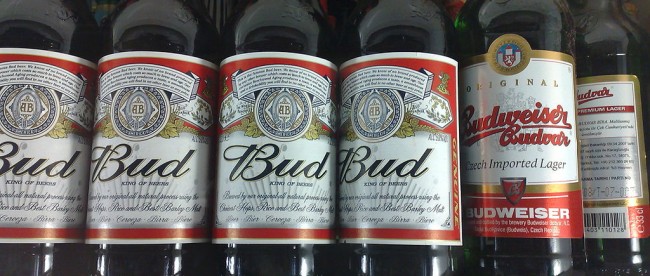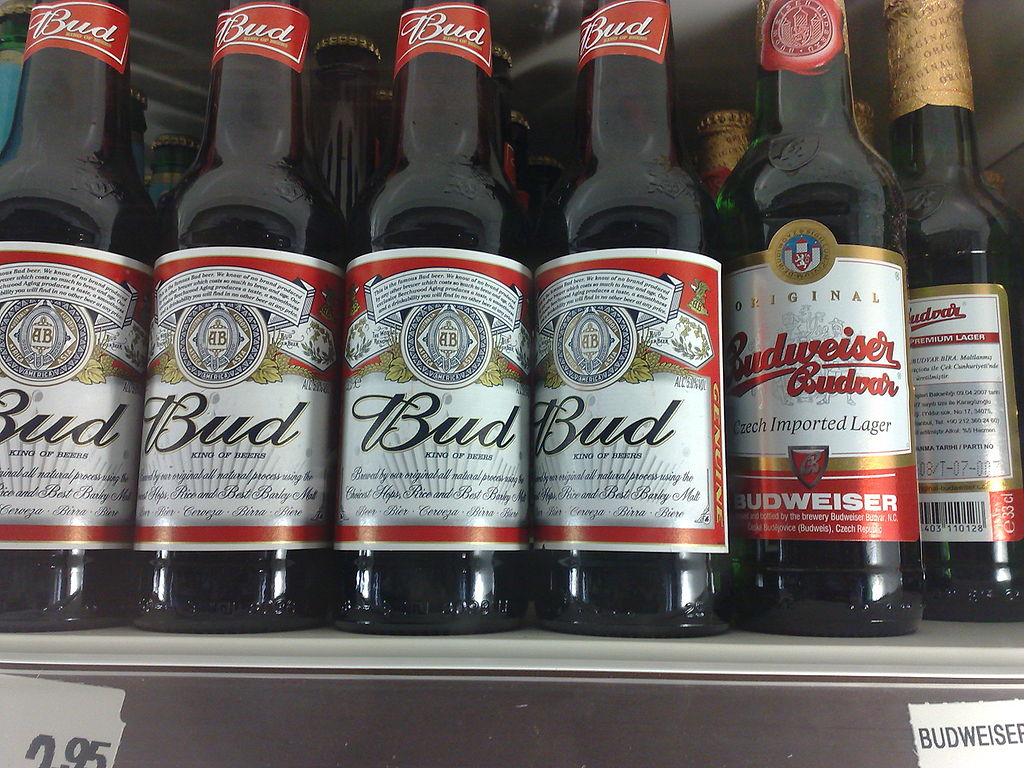Buds But Not Buddies


The four bottles on the left, above, are bottles of what an American would call Budweiser. And, if you’re an American especially, you know it well, even if you don’t drink it. The marketing and branding around the product permeate the cultural landscape, from the “This Bud’s For You” and “King of Beers” taglines to the Clydesdales and the “Bud-Wize-Errr” burping frogs. And to drive home how American Budweiser is, AB InBev (its Belgian owner) is even temporarily changing the branding to say “America,” with much fanfare.
And yet, there’s something amiss about the labels on those bottles of Budweiser — they don’t actually say “Budweiser.” These bottles use the “Bud” nickname, instead.
But the bottle to the right? It clearly says “Budweiser,” albeit in a different font. If you look closely, you’ll see the words “Czech Imported Lager” on the label, too — and the Czech Republic, if you look at a map, isn’t part of America.
What’s going on?
Let’s start in the Czech city of České Budějovice, known as Budweis in German, and let’s go back to the 1200s, when the area was part of the Kingdom of Bohemia. At the time, Budweis was one of the few places allowed to brew beer, and “beer from Budweis” — or, “Budweiser Bier” — became as well known as virtually anything in Bohemia could be. (For most of the latter part of the Bohemian era, German was the most common language in the area.) While the term “Budweiser Bier” fell into disuse over time, the tradition of brewing beer in Budweis persisted for generations and, for that matter, centuries. During a tour of European breweries in the 1870s, Anheuser-Busch patriarch Adolphus Busch was introduced to the beer made in the town — and he was impressed.
So in 1876, Anheuser-Busch (the predecessor to AB InBev) introduced to American a concoction inspired by what Mr. Busch discovered on his travels. This imitation lager was named “Budweiser” in honor of (or to free-ride on) the beer from Budweis and over time, Anheuser-Busch’s “Budweiser” became a (very) well-known brand in its own right. There was only one problem — Anheuser-Busch never told the brewers of Budweis about the Americanized version. And in 1895, Czech brewers, independent of what was going on in St. Louis, created their own “Budweiser.”
Shortly thereafter, Budweiser (American) and Budweiser (Czech) learned about one another. And since then, the two beers have been at odds over the name. Both have filed lawsuits around the world, hoping to own the “Budweiser” name, and with the exception of a brief period in 1939, the two haven’t been able to find much common ground at the negotiating table. Instead, the two have had to find a way to co-exist while not running afoul of each other’s intellectual property rights — rights which vary based on where you are.
As a result, in some places, Budweiser isn’t the Budweiser you’re used to — although typically, the familiar beer is available under a different name. TIME sums up how it shakes out: “While there are exceptions, in much of Europe, [the Czech company] has the rights to the name Budweiser, forcing Anheuser-Busch InBev to use the name Bud. The reverse is true in much of the rest of the world. In the United States and Canada, the Czech beer is sold as Czechvar.” The image at the top? It’s from a shelf in the European Union, per Wikipedia.
Bonus fact: Whether Budweiser is truly the King of Beers is something for the beer connoisseurs to decide, but let’s give Bud credit — they’re one of the kings of marketing. Unfortunately, they’ve overreached a few times. One example dates back to 1983, when Budweiser sponsored the creation of a video game called “Tapper.” In the game, players controlled a bartender who has to fill the beer mugs of demanding customers before the patron reaches the bartender (costing the player a life). Here’s a screenshot of the game, and you can see the Budweiser logo displayed prominently. But not everyone was happy with the idea of a video game — meant (arguably) for kids — was promoting alcohol. As a result, the game’s publisher, Bally Midway, created an alternative version: Root Beer Tapper. As seen here, the game is almost identical, but instead of a Budweiser logo, there’s a “Root Beer Tapper” sign.
From the Archives: This Bud’s For Whom?: How Budweiser reintroduced soccer to beer — in what may be another of those marketing overreaches.
Take the Quiz: Can you name the countries that have the highest per-capita alcohol consumption rates?
Related: A homebrew beer making kit. Make your own beer, just don’t call it Budweiser.
